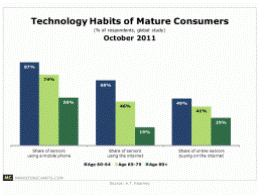Courtesy of Marketing Charts,
October 3, 2011
 Mature consumers around the globe are using technology at high rates, according to the A.T. Kearney Global Maturing Consumer Study. Data from the study indicates 87% of global consumers age 60-64 use a mobile phone, as do 74% of those 65-79 and 50% of those 80 and older.
Mature consumers around the globe are using technology at high rates, according to the A.T. Kearney Global Maturing Consumer Study. Data from the study indicates 87% of global consumers age 60-64 use a mobile phone, as do 74% of those 65-79 and 50% of those 80 and older.
Mature usage rates for internet and internet shopping are not quite as high but still show some solid penetration among the 60 and older set.
For example, 68% of consumers age 60-64 use the internet, although this figure drops to 46% for consumers 65-79 and 19% for consumers 80 and up. Out of online mature consumers, 49% of those 60-64 shop online, as do 41% of those 65-79 and 29% of those 80 and older.
Sixty-nine percent of respondents have both fixed-line and mobile phones. The percentage that uses only a mobile phone is 11%, while 22% have fixed-line phones only. In addition, exactly half of the survey respondents use the internet, with 20% taking advantage of it for shopping, research and communication.
Mature Consumers Display Unique Shopping/Spending Habits
Two-thirds of those aged 70 to 80 say they shop twice a week or more. They shop at different times, preferring to go on weekdays, and relatively early in the mornings, when the stores are less busy. The older they are, the more they prefer smaller stores and shopping closer to home (68%), and the more likely they are to walk to the shops rather than drive or be driven. A.T. Kearney analysis shows proximity is almost always a main reason for choosing a specific store.
In addition, mature consumers spend proportionally less of their income on clothing and transportation than people under age 60, and more on food, beverages and non-prescription health products. They buy fewer items but tend to spend more per item.
A.T. Kearney data indicates that overwhelmingly, mature consumers seek quality products, are loyal to brands, and are not particularly price sensitive, even if their incomes are below average levels. This trend is even more pronounced with aging.
Mature Spend Will Almost Double by 2020
Worldwide, consumers aged 60 and older spent more than $8 trillion in 2010; by 2020, A.T. Kearney projects they will spend $15 trillion, or a close to 90% increase. An analysis of the share of income for the older-than-60s in various economic regions shows that it will continue to rise through 2020.
Price Alone Not Enough for 4 in 10 Mature Consumers
More than four in 10 (43%) study participants say they will buy promotional products only if they believe the quality is comparable to their usual purchase, 34% say they buy goods on promotion whenever they can, and 22% say promotions have no impact on them.
Harris: Mature Consumers Less Likely to Cut Back
Although they are more likely to be on a fixed income, mature US consumers age 66 and older are less likely than younger consumers to have cut back spending in many areas during the last six months than their younger counterparts, according to March 2011 Harris Poll data. Lower rates of cutting back on spending for three of these activities, brown-bagging lunch, buying a morning coffee, and carpooling, may reflect the lower percentage of mature consumers in the workforce.
About the Data: A.T. Kearney’s Global Business Policy Council launched a global survey of 2,947 people in 23 countries. Participants are from cities, towns and rural areas, belong to all income brackets and age groups (60s, 70s and 80s). Half of the surveys were performed in face-to-face interviews in a variety of shopping environments: hypermarkets and shopping malls, supermarkets, street markets and small shops. The other half were conducted via questionnaires posted on the A.T. Kearney website, with additional information usually gleaned in face-to-face or telephone interviews with respondents.










Join the Discussion
Type out your comment here:
You must be logged in to post a comment.